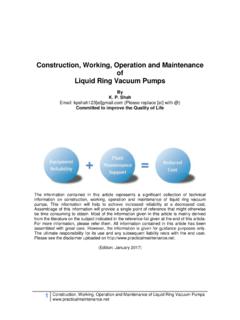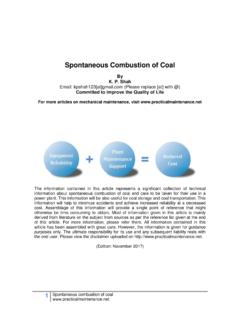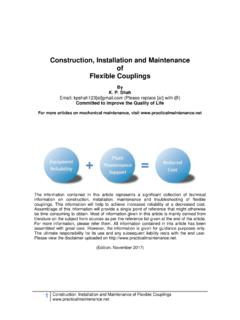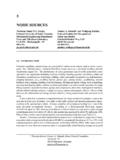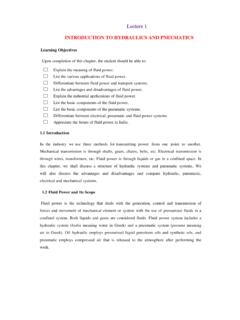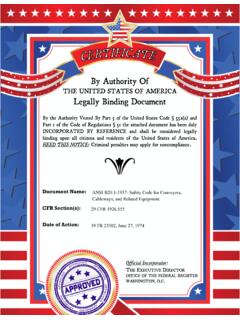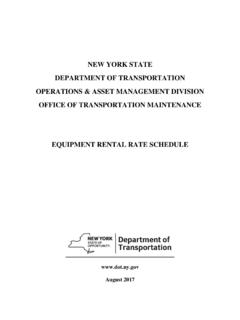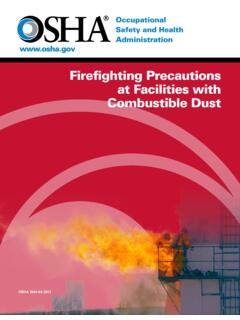Transcription of Working, Design Considerations and Maintenance of Bag …
1 1 working , Design Considerations and Maintenance of Bag Type Fabric Filters working , Design Considerations and Maintenance of Bag Type Fabric Filters By K. P. Shah Email: kpshah123[at] (Please replace [at] with @) Committed to improve the Quality of Life The information contained in this booklet represents a significant collection of technical information on working , Design Considerations and Maintenance of bag type fabric filters (mechanical shaker, reverse air and pulse jet type baghouses/filters).
2 This information will help to achieve increased reliability at a decreased cost. Assemblage of this information will provide a single point of reference that might otherwise be time consuming to obtain. Most of information given in this booklet is mainly derived from the literature on the subject indicated in the reference list given at the end of this booklet. For more information, please refer them. All information contained in this booklet has been assembled with great care. However, the information is given for guidance purposes only and the ultimate responsibility for its use and any subsequent liability rests with the end user.
3 Please see the disclaimer uploaded on (Edition: January 2017) 2 working , Design Considerations and Maintenance of Bag Type Fabric Filters Content Chapter Title Page No. 1 introduction 3 2 working of Bag Type Fabric Filters 4 3 Advantages and Disadvantages of Fabric Filters 6 4 Particle Collection in Fabric Filters 7 5 Fabric Materials 12 6 Bag Failure Mechanisms and Fabric Testing 15 7 Mechanical Shaker and Reverse Air Baghouses 17 8 Pulse Jet Baghouses 22 9 Fabric Filters Design Considerations 36 10 Safety 43 11 Maintenance of Bag Houses 44 12 Useful Terms 46 - References 50 3 working .
4 Design Considerations and Maintenance of Bag Type Fabric Filters introduction Gas-solid separation devices associated with pneumatic conveying systems have two functions. To recover the conveyed material as much as possible and to minimize pollution of the environment by the working material. Different separation mechanisms used based on the size of particles are: gravity settling chambers, cyclone separators and bag type fabric filters. If a bulk material consists of relatively large and heavy particles, with no fine dust, it may be possible to collect the material in a simple bin, where the solid material falls under gravity to the bottom of the bin while the gas is taken off through a suitable vent.
5 However, if a bulk material is of slightly smaller particle size, it may be required to enhance the gravitational effect. The most common method for this is to impart spin to the gas-solid stream so that the solid particles are thrown outwards while the gas is drawn off from the centre of the vortex. A cyclone separator works on this principle. If particles are fine and especially if they are also of low density, separation in a cyclone may not be fully effective, and in this case the gas-solid stream may be vented through a fabric filter.
6 For materials containing extremely fine particles or dust, further refinement in the filtration technique may be necessary, for example, use of wet washers or scrubbers and electrostatic precipitators. In general, the finer the particles that have to be collected, the higher will be the cost of a suitable separation system. Airborne dusts which may be encountered in industrial situations are generally less than about 10 m in size. Particles of this size can be taken into the body by ingestion, skin absorption or inhalation.
7 The former is rarely a serious problem and, although diseases of the skin are not an infrequent occurrence, it is inhalation that presents the greatest hazard for workers in a dusty environment. Particles falling in the size range of approximately - 5 m, if inhaled, can reach the lower regions of the lungs where they will be retained. Prolonged exposure to such dusts can cause permanent damage to the lung tissues (pneumoconiosis) symptomized by shortness of breath and increased susceptibility to respiratory infection.
8 In view of above, information about working of bag type fabric filters, fabric materials, different types of bag type fabric filters, Design Considerations , Maintenance of fabric filters (pulse jet type) and useful terms related with fabric filters is given in this booklet. 4 working , Design Considerations and Maintenance of Bag Type Fabric Filters working of Bag Type Fabric Filters In pneumatic conveying systems handling fine or dusty material, the method of filtration that has become almost universally adopted is a bag type fabric filter.
9 These filters are commonly called baghouses. Most baghouses use long, cylindrical bags (or tubes) made of woven or felted fabric as a filter medium. Dust laden gas or air enters the baghouse through hoppers by suction (normally) or positive pressure and is directed into the baghouse compartment. The heavier dust particles fall off at the entry itself, while the lighter dust particles along with gas get carried upward to the bags. The gas is drawn through the bags, either on the inside or the outside depending on cleaning method, and dust accumulates on the filter media which increases the resistance to gas flow.
10 Due to this, the filter must be cleaned periodically when sufficient pressure drop occurs. During cleaning, dust that has accumulated on the bags is removed from the fabric surface and deposited in the hopper for subsequent disposal. Depending on the type/construction of baghouse, cleaning can be carried out while the baghouse is on-line (filtering) or is off-line (in isolation). If gas enters into the baghouse tangentially at the bottom of the casing, it gives the dust laden gas a circular motion which helps in removing the heavy and coarser particles that are present in the gas stream in a manner similar to a cyclonic collector.


